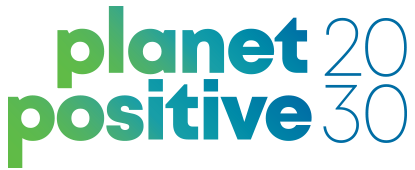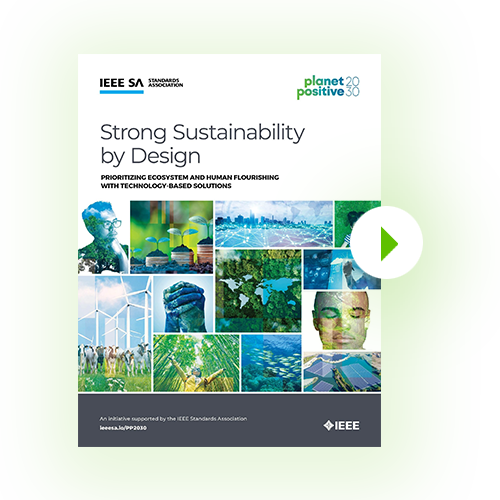By Ronald Hasenberger, Principal Consultant, Bell Labs Consulting
The metrics section of PP2030 Strong Sustainability by Design (SSbD) includes several references towards technology and the use thereof for the benefit of the environment.
This blog expands the awareness of how technology can be applied to issues of Sustainability and identifies areas where new data/insights/knowledge (i.e., metrics/indicators) can enhance our capacity to improve performance. I want to emphasize here that this post is focussing on the use of technology for the benefit of the environment and is thus inherently not going to highlight the potential for negative impact by technology (that I am very much aware of). Another aspect being that this is intended to provide examples of the use of technology for sustainability and should by no means be considered exhaustive in any aspect.
The main technologies I am going to turn towards for this blog are:
- Internet of Things
- Digital Twins
- Artificial Intelligence
Problem statement
To understand the behaviour of systems, insight into the systems working is required. For many systems (e.g. woods, rivers, cities) the foundation for these insights is typically gained by measuring attributes of the system, which may be aspects like
- Temperature
- Humidity
- Rainfall
- Population (which may be human, animals, plants, microbes, cars, robots,…)
Insights into these systems can and need then to be combined to systems on the next higher aggregation level up to the upmost system, which is the earth.
Measurement of these attributes is possible, nevertheless executing these measurements with the required special and timely resolution requires lots of sensors with corresponding networks to enable efficient data gathering.
Given the amount of sensors required to cover a given geographic area getting full coverage over extensive areas (in the end we need to get reasonable understanding of the whole world) would require a lot of resources of different kind (and even if the cost of deploying humongous swaths of sensors over the globe is ignored the deployment of lots of gadgets also uses lots of material and energy to run it). Thus, the deployment of sensors can be expected to be limited to cover only parts of the geography of interest and other means are required to extend our understanding.
The following section gives an overview on the interplay of the solutions being employed with the sections afterwards providing some more detail on the individual components.
Overview
The limitation of feasibility (what can be measured in which part of the globe) can be augmented and/or enhanced through virtual representation of the systems that effectively represent the attributes in regions that are not covered by direct measurement. This augments the information to provide multi-dimensional profiles for enhanced insights on impact and optimal decision making in extended regions (ideally globally).
Figure 1 – Viewpoint alignment
Figure 1 shows the simplified relationship between the different granularity levels with the arrows highlighting the means at work to help supplement / improve the information that can be gained on the different levels.
To start in the middle: a local and reasonably detailed view of the system under observation can be achieved by using technologies from the Internet of Things (IoT) space, i.e. sensors equipped with appropriate means of communication. Based on this data, Digital Twins can be used to gain additional insights about the system that are not directly observable (3).
These insights from Digital Twins can be used to guide future instrumentation of the system and lead to action (4).
Combining the local details with information gathered by global observation using artificial intelligence can create models that allow the extraction of similar insights from areas that are not completely instrumented, thus achieving a high quality global view without having to distribute sensors over the whole globe (2). A pre-condition for this extrapolation is the capability to identify the areas where the models are applicable.
The global view can also identify areas for which no detailed model exists, which can lead to instrumentation in these areas (1).
Details on the components
In this section some of the components introduced above are described in context of their respective interaction and how they can be used in combination to gain valuable insight. This will enable an assessment of the current situation and achieved improvement.
Data gathering / Measurements
Detailed data gathering is typically based on IoT devices. Dependent on the environment such devices are communicating their data back to some central location using different means. In reasonably developed areas a prime contender for backhauling data are cellular technologies. Most of the currently used cellular technologies are members of the 3GPP family of standards. 5G is already available in many locations; 6G is currently under development and expected to be deployed in the 2030s. Other technologies like LoRaWAN are also used for gathering IoT data. These technologies can provide connectivity to a large number of devices while at the same time supporting very low power modes of the devices, enabling battery lifetimes up to 10 years — which is also dependent on the communication demands (how much data has to be transmitted how often) as well as the power requirements of the measurement circuitry as such.
In areas with little available infrastructure (e.g. the jungle around the Amazon) the cellular approach mentioned above is most likely not going to work (at least not the current ones). Nevertheless, technologies also exist to support this kind of environments. These are self-organizing mesh networks where the devices themselves build a network autonomously (and drop the data off in few locations onto the “generic internet”). Given the right communication protocols, inter device distance and sensor technology such technologies are also capable of supporting battery lifetimes of several years.
Both approaches use cloud computing in conjunction with edge clouds (clouds that are providing their processing close to the end user) and local processing to maximize battery lifetime as well as overall energy consumption by optimizing the power demand for local processing of the data (reducing the amount of data to be transferred) against the power demand for communication purposes.
Extrapolation
As stated above it is not feasible to cover the whole world with sensor networks to achieve global data coverage based on actually measured data. It is even less feasible (actually impossible) to directly measure future states of the system.
Nevertheless, technology provides solutions that help overcome these hurdles.
Sensor integration
Integration of sensor platforms with different spatial properties can help deal with the geographic coverage topic – especially when used in conjunction with some of the technologies described here.
IoT devices can be deployed with high density over a limited area as described in the section Data gathering. This information can be combined and extended with information from another sensor system, e.g. one that is satellite based. Satellite based systems can provide large spatial coverage (whole earth is doable with satellite systems dependent on the satellite orbit configuration) with limitations in terms of measured attributes and spatial resolution.
Utilising sensor integration the relation of the highly detailed data from the IoT domain with the data gathered using the satellite-based system can be used to create models that enable high quality estimation of detailed information (typically not to the same degree as with IoT based data gathering but still) based on satellite data.
Digital Twins
Digital Twins come in a wide variety of forms (see [2] for an enumeration of a selection of flavours of Digital Twins).
The more sophisticated Digital Twins are capable of simulating the system that is reflected by the twin which enables insights into aspects that are not available for direct measurement.
This can play a valuable role to extend insights in areas that are subject to detailed interrogation with a dense scattering of IoT devices. This would be achieved by model(s) that derive these insights from the actually measured data. Such models may be created on the basis of a theoretical understanding of the system at hand or from empirical assessment of sample areas with higher human contribution.
On the other hand, Digital Twins can be used to create insights resembling those from highly detailed measurements utilizing less dense basic data (e.g. from satellite-based observations) utilizing relations of data measured on different granularities to build such a model (such relations would often be created using Machine Learning).
Digital Twins of the simulating kind can also be used to extrapolate properties of the system into the future which can be used to create forecasts for the behaviour of the system in the future for different scenarios/border conditions.
Artificial intelligence (Machine Learning)
Artificial Intelligence is also coming in different forms and functions with different applicability for different means (see [3] for a [telecommunications focussed] assessment).
Especially the Machine Learning / Data Science portion of artificial intelligence can do a great job in learning relationships and applying these relationships in other areas.
Given the relationships discussed above Artificial intelligence (Machine Learning) will be employed to help extend the insights gained from areas monitored in detail towards whole earth coverage by unearthing the relationship between satellite based and locally captured data.
Another application area of Artificial Intelligence (Machine Learning) is the capability to help glean additional insights out of the systems that are already monitored in high detail by its capability to patiently and without fatigue sift through huge datasets.
References
- Toward Massive Scale Air Quality Monitoring, Naser Hossein Motlagh et. al. , IEEE Communications Magazine Feb. 2020
- Digital Twins: From Conceptual Views to Industrial Applications in the Electrical Domain, Giovanna Di Marzo Serugendo et.al., IEEE Computer Magazine Sep. 2022
- AI – What AI, Ronald Hasenberger, Linked In
Author Bio
Ronald Hasenberger is a Principal Consultant at Bell Labs Consulting working on Operations and Transformation in the ICT environment. He can be reached at linkedin.com/in/ronaldhasenberger.
Disclaimer: The thoughts/opinions expressed in this blog post are my own and do not necessarily align with those of my employer or the IEEE.




